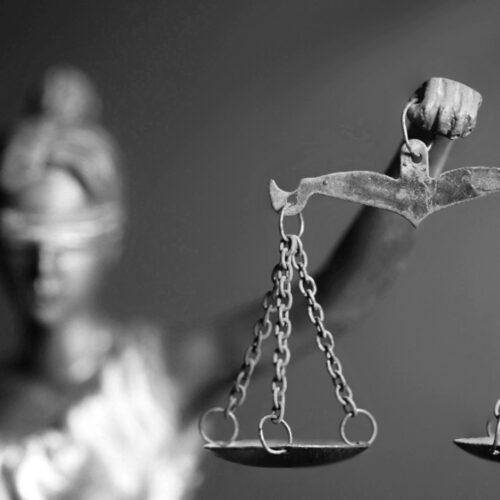You Cannot Defend Yourself

Editor’s Note: The first step in winning a war is to recognize the fact that you are in one. This means, first and foremost, to come to know your enemy and his goals. In a recent essay for this site, Glenn Ellmers and Ted Richards of the Claremont Institute make a compelling case that the present enemy—the “woke” or group quota regime—is a totalitarian threat, and that its aims are nothing short of revolutionary. While our own troubles may seem far removed from the hard totalitarianism of the twentieth century, Ellmers and Richards argue that the six traditionally accepted elements of totalitarianism are already present in woke America. What’s more, they identify three factors that are unique to the tyranny of the present day.
It is customary to think of totalitarian regimes as especially brutal in their use of force. In many ways ours is, so long as the targets are the right ones. Yet Jeremy Carl argues that the emerging totalitarianism is most defined by its prohibitions on force: in gun control, in the criminalization of self-defense, and especially in the opening of our border. If the group quota regime emerges victorious from the cold civil war, it will be in no small part because it succeeded in disarming its enemies. This is the fourth in a series of nine contributions by leading experts on the nine defining elements of what Ellmers and Richards dub “Totalitarianism, American Style.”
As the namesake of this web site has suggested, it is indeed true that the essential first step to winning a war is to acknowledge that we are in it. This creates a deep problem for the right, because—with some honorable exceptions such as many of my colleagues at Claremont—most people on the right, from the think tank world to (especially) our elected representatives, are clueless about the struggle we are in. They prefer to think of themselves as participants in an actual two party system of governance, rather than an elaborate kayfabe in which the GOP plays the Washington Generals to the Democrats’ Harlem Globetrotters.
The use of force provides perhaps the closest thing we get to a glimpse behind the mask. If war is in fact, as Clausewitz said, the continuation of politics with other means, then the question of force is perhaps the fundamental political question in any society—especially a society in crisis. It is here that the sunny euphemisms of the left’s bureaucratic quasi-tyranny must give way to the visible exercise of raw power. This is where the emerging regime flexes its strength; but this revelation is also a weakness, because power prefers to remain unseen and in the shadows.
The current form of encroaching tyranny has several different elements. As Glenn Ellmers and Ted Richards document in the article which started our discussion, the federal government every day tightens its monopoly on the legitimate use of force. Consider: Between 2006 and 2016, federal government agencies excluding the Department of Defense spent almost $4 billion on military equipment of various types. Over the last decade, that number has doubtless risen further. The killer takeaway: There are now more federal agents with arrest authority and firearms than there are U.S. Marines. As our ability to successfully project power outward declines, the regime increasingly projects power inwards, against our own citizenry.
And more politically active members of that citizenry are growing increasingly concerned, especially in states like Montana, where I live—a Shire that, most days, is far from the Federal government’s “eye of Sauron.”
A friend of mine who lives nearby, a highly educated local rancher and scholar, once took me around to local excavation companies as he looked for someone who would build an underground storage bunker to hide his (entirely legal) weapons. My friend is not paranoid; but he is, like many longtime Montanans, increasingly nervous about the threats of government to his fundamental liberties.
The Second Amendment is arguably the greatest defense against tyranny: the constitutional right through which, ultimately, we vindicate all of our other rights and ensure they do not just exist on paper. Yet it has long been a prime target for the emerging regime, which attacks lawful registered gun-owners because its ideological predispositions do not allow it to have honest conversations about the real sources of violent crime in America.
As many on the right have long suggested, the Second Amendment has been understood since the Founding as a central bulwark of American liberty. Thus, it is unsurprising that our quasi-tyranny intentionally targets it. In Federalist 46, Madison speaks of the importance of the fact that “Americans have the right and advantage of being armed” a distinct advantage compared to the other countries of the world. Thomas Jefferson proposed in the Virginia Constitution a provision that “No Free man shall ever be debarred the use of arms.” And in his commentary on Blackstone, noted colonial era law professor St. George Tucker noted, “Wherever standing armies are kept up, and the right of the people to keep and bear arms is, under any color or pretext whatsoever, prohibited, liberty, if not already annihilated, is on the brink of destruction.” A refusal to let the government claim a complete monopoly on force—the right and ability of citizens to challenge it—has been a defining characteristic of the American experiment.
Indeed, it is no coincidence that the American Revolution’s first shots were fired by a volunteer militia at Lexington and Concord, where British soldiers had been sent to find what the rulers of state believed to be weapons that could be used to challenge their monopoly.
Federal Force, State Force, and Local Force
But the questions surrounding the use of force are not simply a matter of the government versus the individual. Much of our encroaching tyranny is expressed in the ever growing heavy-handedness of the federal government in asserting its rights against those of the states. This is a common power dynamic throughout American history.
Yet the old dynamic can be easily reversed. When it suits the left’s needs, federal and state laws can be effectively nullified by local officials in our major cities. And left-wing states like California can openly defy the federal government and its laws by refusing to use local force. Most dramatically, in February 2024, the Hawaii Supreme Court ruled that the 2nd Amendment to the United States Constitution should be overridden because it violates Hawaii’s “Spirit of Aloha.”
Outside the court system, see this devolution in the use of force in the recent disruptions that have roiled America’s campuses. Leftist governments at all levels have been reluctant to use lawful force against students, because such students are, in many ways, arms of the regime—like the Red Guards that Mao used so effectively to cement his own power over rival factions in China’s Cultural Revolution. However, just as under Mao, the American red guards have now turned against their sponsors, threatening the regime’s ruling coalition—and it is only for this reason that you are beginning to see the use of state force against them.
Just weeks ago, a group of not more than twenty pro-Palestinian protesters shut down the Golden Gate Bridge in busy San Francisco for five hours, safe in the knowledge that they would suffer no real penalty or criminal charge. Indeed, law enforcement can sit right next to them and do nothing to remove them from the roadway. As members of the regime, they can act with impunity. Law enforcement understands that.
In our modern quasi-tyranny, these are the rules of engagement. Or, as the Peruvian Field Marshal Oscar Benavides said: “For my friends: Everything. For my enemies: The law.” And this is how we see force being exercised in blue jurisdictions: Black Lives Matter can burn cities and cause a record $2 billion of damage and 19 deaths with few arrests and virtually no serious prosecution of the criminals. Yet when some Trump supporters are involved in a riot at the Capitol causing far less damage than dozens of BLM riots—and only one death, at the hands of an armed federal law enforcement officer—the entire military and legal force of the state is turned against them.
I remember, as an official in the Trump administration, the bleakness of the last two weeks Trump was in office. Not because I or my colleagues believed the laughable “insurrection” narrative the left was peddling, but because, after January 6, the police/military state had become so immediately oppressive: every movement in the Capitol controlled, combined with the tyranny of COVID lockdowns, approaching as close to a pure dystopia as anything I have experienced in America. I was deeply relieved when I was finally able to escape D.C. and begin my long drive back to my home in Montana.
The Victims and the Consequences
But such problems were not limited to January 6. Time and again we see the fundamental rights of those who are not favored by the regime left unprotected in left-wing jurisdictions, from New York to Portland. When right-wing citizens defend themselves in these jurisdictions they throw themselves at the mercy of a state which seeks to crush them. We see this in the person of Kyle Rittenhouse, the young man who shot three violent felons in self-defense after they attacked him during the BLM riots in 2020. It may only be because Rittenhouse lived in a politically mixed jurisdiction that he survived his political prosecution.
Daniel Penny, whose heroic actions in the New York subway to save passengers from a dangerous schizophrenic unfortunately resulted in the death of the latter, may not be so fortunate. He has been charged with murder, since such a use force cannot be sanctioned by a liberal city that fails to protect its own inhabitants. Lurking not far beneath the surface, of course, is the fact that both Penny and Rittenhouse were the wrong race of someone using force for self-defense in 2024.
Beyond any single court case, however, the failure of the federal monopoly on force is most apparent in the immigration crisis. Florida Governor Ron DeSantis and, in particular, Texas Governor Greg Abbott have made headlines challenging the federal government’s refusal to use its lawful monopoly force to repel the ongoing invasion at America’s border. Finally despairing of the inaction of a federal government that “stands in the schoolhouse door” blatantly refusing to enforce America’s laws, Texas began to use implicit force of its own, constructing barbed wire border barriers and in vulnerable points and other obstacles to illegal crossing at the Rio Grande.
Texas and Florida have both moved, too, to be able to deport illegals in accordance with federal law, in cases currently winding their way through the courts. Completely unvetted illegal aliens, many from countries we have listed as state sponsors of terrorism, continue to arrive within our borders as the federal government fails to utilize its monopoly force—and as all other potential agents are barred from action by the federal monopoly claim.
Note that the legal questions being raised here are not questions around nullification (a tactic that, contrary to leftist mythology, was first substantially used by Northern states in defiance of Southern laws regarding the forcible return of fugitive slaves under the Fugitive Slave Act). This is simply conservative states declaring that they can use force to execute what is unquestionably existing federal law when the federal government refuses to do so. Particularly since the Obama administration, the federal government has blatantly refused to enforce many federal immigration laws, declaring that “enforcement priorities” dictate going after only criminal aliens. (This itself is a fanciful claim and an excuse for keeping the border open, of course; but liberal courts are happy to take it at face value.)
And this federal refusal to use force has consequences in letting in millions of largely military-age-males illegally into the country. In The Fall of the Roman Empire: A New History of Rome and the Barbarians, Peter Heather, the distinguished British historian at King’s College London, has argued that exactly such movements into the Roman empire of various “barbarians” in the 4th century, not repelled by force, would lead to the empire’s 5th century collapse.
Closer to home and our own time, the historical case of Texas under Mexican governance shows how open borders and the refusal of a regime to apply force effectively in policing borders can stoke internal revolution. Mexican authorities let so many Anglos settle in their country that, by the last years of Mexican rule over Texas, Anglos already outnumbered Texans of Hispanic origin. Those Anglo Americans (combined with some Hispanic Texans) would eventually lead to the collapse of Mexican Texas and the birth of the Independent Republic of Texas, which would soon become part of the United States.
Nearly two centuries later, the failure to secure our border by force has hastened along another such demographic shift—a neglect worsened by the active quashing of any attempt to challenge the federal government’s deadbeat monopoly (even as state force is used liberally elsewhere against domestic political opponents). The course of those challenges—on the one side, an American tradition stretching back to Lexington; on the other, a creeping totalitarianism—may well determine whether another regime on the same piece of land will suffer the same fate.
Jeremy Carl is a senior fellow at the Claremont Institute and a former Deputy Assistant Secretary of the Interior under President Trump. His book The Unprotected Class: How Anti-White Racism is Tearing America Apart, has just been released by Regnery/Skyhorse Publishing.



